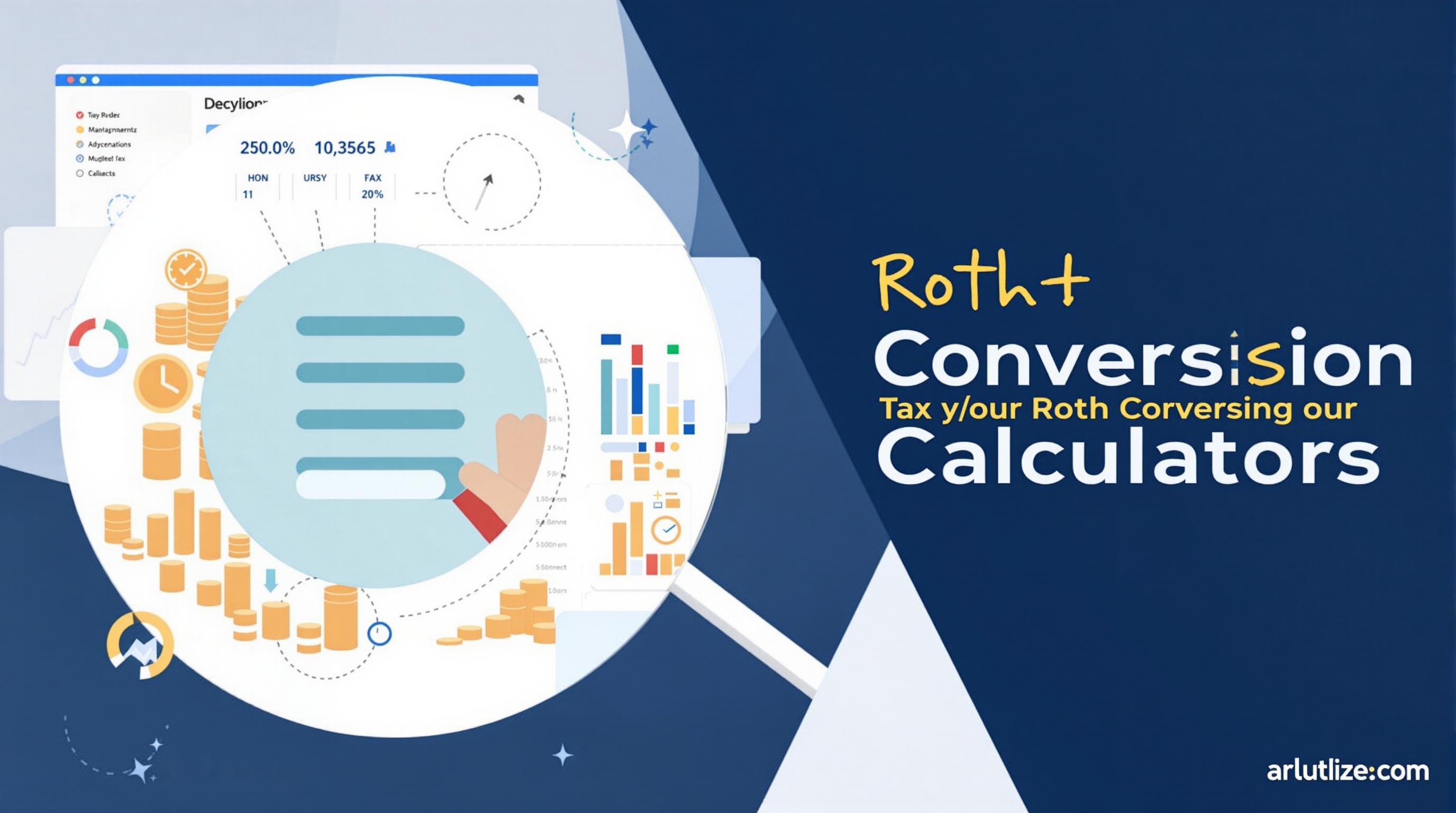Related Articles
- Top 6 Quantitative Hedge Funds Launched Since 2019 That Challenge Traditional Diversification Models
- Top 8 Cutting-Edge Retirement Income Vehicles From the Last Five Years Revolutionizing Financial Freedom
- Uncovering the Role of Behavioral Biases in Roth Conversion Decisions and Their Impact on Long-Term Wealth
- Top 6 Revolutionary Dividend Reinvestment Platforms Launched Since 2019 Redefining Passive Income Growth
- Top 7 Breakthrough Retirement Income Platforms Launched in the Last Five Years Compared and Ranked
- The Untold Influence of Cultural Artifacts on Expanding Investment Horizons and Mitigating Financial Risks
9 Little-Known Roth Conversion Scenarios That Could Affect Your Social Security Benefits and Tax Bracket
9 Little-Known Roth Conversion Scenarios That Could Affect Your Social Security Benefits and Tax Bracket
9 Little-Known Roth Conversion Scenarios That Could Affect Your Social Security Benefits and Tax Bracket
Roth conversions have become a popular strategy for managing retirement income and taxes, but not all scenarios are straightforward. Many retirees and pre-retirees may find themselves facing unexpected tax implications or changes to Social Security benefits when converting traditional IRA assets to a Roth IRA. Understanding these nuances can help you better plan your retirement and avoid surprises in your tax bracket or Social Security payments.
In this article, we explore nine lesser-known scenarios where Roth conversions intersect with Social Security benefits and potential tax bracket changes. Each section offers insights to help you navigate these complexities and make informed financial decisions.
Let’s dive into these scenarios and see how a Roth conversion could impact your overall retirement plan.
1. Roth Conversion Income Increasing Social Security Taxation
When you perform a Roth conversion, the amount converted is treated as taxable income for the year. This increase in income can push you into a higher provisional income bracket, which determines how much of your Social Security benefits are taxable. The IRS uses a formula to determine if up to 85% of your Social Security benefits become taxable based on your combined income, including Roth conversions.
This means that while converting to a Roth IRA might reduce future required minimum distributions (RMDs), the short-term tax bump could increase the taxability of your current Social Security benefits. Many retirees overlook this interaction and are surprised by higher taxes after a conversion year.
Planning your conversion amounts carefully and considering the timing relative to Social Security claiming can reduce unintended tax consequences and maintain your tax bracket.
2. Early Roth Conversions Affecting Medicare Premiums
Medicare Part B and Part D premiums are income-related and can increase significantly with higher reported income. Because Roth conversions count as income for the year, even temporary boosts can expose you to higher Medicare premiums in the subsequent years.
This scenario is particularly important for individuals just above the income thresholds ($97,000 for individuals, $194,000 for couples in 2024) where Medicare premiums increase progressively. A large Roth conversion could move you into a higher income bracket for Medicare purposes, resulting in surcharges that may last for several years under the IRMAA (Income-Related Monthly Adjustment Amount) rules.
To avoid these premiums, some retirees choose to spread conversions over multiple years or convert smaller amounts that keep them under the IRMAA thresholds.
3. Converting in Years Without RMDs Boosts Taxable Income
After age 72, RMDs from traditional IRAs typically increase your taxable income significantly. However, Roth conversions don’t generate RMDs, which makes them a good tool for tax planning. Yet, converting large sums in years when you have no RMDs (such as before age 72) can still substantially increase your taxable income and affect your current tax bracket.
This increment can, in turn, influence the taxability of Social Security and push you into a higher marginal tax bracket unexpectedly. Especially for those taking Social Security benefits early (age 62 or older), the additional income from conversions should be carefully balanced with your overall income and tax picture.
Consulting with a tax advisor can help identify the optimum years and amounts for conversions to avoid spikes in income that impact your retirement tax efficiency.
4. Roth Conversions May Affect Your Tax Bracket More Than Expected
It's common to underestimate how much a Roth conversion will increase your taxable income and push you into a higher tax bracket. Because the conversion amount adds to your ordinary income, it can move you into the next tax bracket, increasing the marginal tax rate on some or all of the converted funds.
For example, converting a large portion of your traditional IRA in one year could push your income from the 12% tax bracket into the 22% or 24% bracket, resulting in a higher overall tax bill. This change can also affect the phaseouts of deductions and credits, making your effective tax rate even higher than anticipated.
Careful tax planning and understanding of your tax brackets, marginal rates, and potential bracket creep are essential before committing to large Roth conversions.
5. Partial Conversions Can Help Manage Social Security Taxation
Instead of converting your entire IRA at once, a strategy of partial conversions spread out over multiple years can help control your taxable income. This approach allows you to carefully manage provisional income to minimize the taxation of your Social Security benefits.
By keeping your income below certain thresholds, you can reduce or avoid the 50% or 85% taxable portions of Social Security benefits. The thresholds for these tiers are generally $25,000 and $34,000 for individuals and $32,000 and $44,000 for couples (as per IRS guidelines).
Partial conversions give retirees flexibility to optimize tax implications without sacrificing the benefits of Roth IRA growth and tax-free withdrawals later in retirement.
6. Conversions Before Social Security Claiming Age Affect Benefits Differently
Roth conversions executed before you begin receiving Social Security benefits can still impact the taxability of those benefits once claimed. However, since you're not yet drawing Social Security, the conversion income may cause you to pay higher taxes but defer the Social Security taxation impact until the benefits start.
This scenario can be advantageous if you plan your conversions earlier in retirement, especially if you intend to delay Social Security claiming past full retirement age to maximize benefits. By smoothing income and conversions before Social Security starts, you may reduce future tax burdens.
Timing conversions relative to Social Security claiming age allows for strategic tax management, but requires comprehensive assessment of your projected lifetime income.
7. Roth Conversions Can Influence State Taxes and Social Security
While Social Security benefits are federally taxed based on income, many states handle taxation of Social Security and retirement income differently. Some states do not tax Social Security benefits but do tax IRA withdrawals and conversions.
Performing a Roth conversion can increase your state taxable income and potentially affect state tax deductions or credits related to Social Security or retirement income. For retirees living in states with high income taxes, this amplifies the need for tax-aware Roth conversion planning.
Understanding your state's tax treatment of conversions and Social Security benefits can help avoid unexpected state tax bills and inform whether Roth conversions are beneficial in your location.
8. Impact on Tax Credits and Deductions
Increased income from Roth conversions can reduce eligibility for various tax credits and deductions. For example, higher adjusted gross income (AGI) levels can phase out eligibility for the Saver’s Credit, medical expense deductions, or the child tax credit.
Since Roth conversions count as ordinary income, even a seemingly modest conversion can push your AGI above thresholds that begin to reduce or eliminate these benefits. This may indirectly raise your overall tax burden beyond just the conversion tax itself.
Review your eligibility for tax credits and deductions when planning conversions to ensure the net tax effect does not outweigh the benefits of Roth IRA growth and tax-free withdrawals.
9. Roth Conversion Timing Around Other Income Sources Matters
Your total income picture — including pensions, dividends, rental income, and part-time work — can interact with Roth conversions to influence taxes and Social Security benefits. A conversion that seems reasonable in isolation might push you into higher tax brackets or increase Social Security taxation once combined with other income streams.
Coordinating Roth conversions with the timing of other income sources is a key planning step. For instance, converting in a year with lower other income components can minimize tax impact and help you better control your tax bracket.
Detailed cash flow and income forecasting, ideally with professional guidance, ensure conversions complement rather than complicate your broader retirement income strategy.
Conclusion
Roth conversions offer valuable tools for retirement tax management, but their effects on Social Security benefits and tax brackets are often underestimated. Each of the nine scenarios discussed demonstrates that timing, income levels, and interaction with other benefits can create unexpected tax consequences or affect Medicare premiums.
Careful, personalized planning — often involving tax professionals — helps ensure Roth conversions achieve long-term tax efficiency without jeopardizing Social Security benefits or increasing current taxation unduly. A comprehensive view of your retirement income sources and goals is essential for successful Roth conversion decisions.
For further guidance, refer to IRS publications on Roth IRAs and Social Security taxation, and consult financial advisors specializing in retirement planning.
Sources:
- IRS Publication 590-A: Contributions to Individual Retirement Arrangements (IRAs)
- Social Security Administration: Understanding How Benefits Are Taxed, ssa.gov
- Medicare.gov: Medicare Costs Based on Income, medicare.gov




